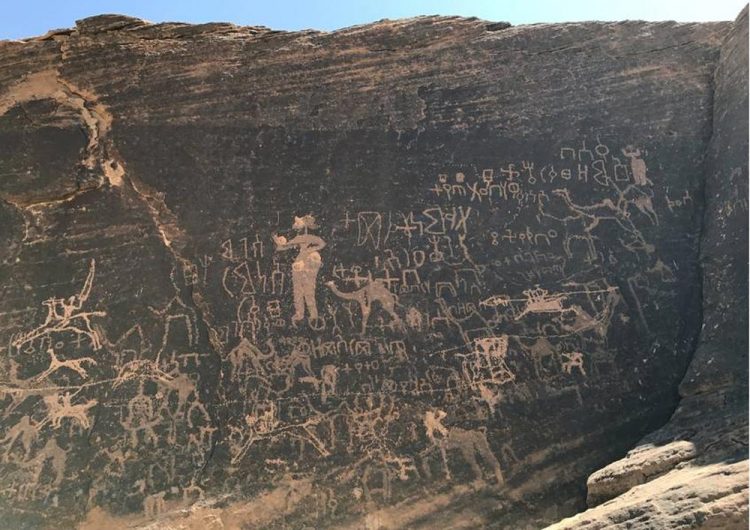The Secret of the Rock Drawings

The rock drawings (also known as petroglyphs) in the Hima region of south-western Saudi Arabia have been intriguing scientists from all over the world for decades. Photo: M. Andreae
Hunting scenes, ritual dances, and mysterious human-like figures with their hands reaching up into the sky: The rock drawings (also known as petroglyphs) in the Hima region of south-western Saudi Arabia have been intriguing scientists from all over the world for decades.
Yet, we still know very little about why and when these rock paintings in the desert were created. To this very day, archaeologists disagree on how old the illustrations are.
An international team led by Professor Meinrat O. Andreae of the Max Planck Institute for Chemistry has now discovered a scientific method that can be used to date the rock paintings more accurately.
The researchers examined the rock varnish in and around the illustrations. Rock varnish is a dark coating that appears on stones and rock faces. This thin, manganese-rich crust can be found on almost all types of rock, but is most common on sandstones in the desert.
This dark surface provided an ideal background for the people who created the petroglyphs, as the freshly cut images stood out clearly against the background of the black varnish. From a geochemical standpoint, petroglyphs are important because they can be used to investigate the development of desert varnish over a period of several thousand years in more detail.
The scientists measured the chemical composition of the image surface and the surrounding rock directly on site using a handheld XRF* spectrometer. Samples were additionally examined in the lab using femtosecond laser ablation ICP mass spectrometry. The data was then compared with measurements conducted on rock engravings, whose age was known based on the writing style used or the engraved dates.
Using the measured manganese and iron values, the MPIC researchers were thus able to date the petroglyphs whose ages were previously unknown in the Hima region. “We have found that the images were created almost throughout the entire Holocene period,” said Prof. Andreae.
The oldest of the images are around 7,000 years old, while the youngest were created a few hundred years ago. “Our datings correspond to the culturally or ecologically derived ages of the animal and human figures depicted in the rock art and to the styles of scripts used in various periods,” continued Prof. Andreae.
Next, the scientists want to use the new method to evaluate data that has already been collected from another region of Saudi Arabia. Subsequent expeditions to North America and China are in the pipeline.
* The abbreviation XRF stands for X-ray fluorescence
Prof. Dr. Meinrat O. Andreae
Max Planck Institute for Chemistry, Mainz
Email: m.andreae@mpic.de
Rock varnish on petroglyphs from the Hima region, southwestern Saudi Arabia: chemical composition, growth rates, and tentative ages
Dorothea S. Macholdt, Klaus Peter Jochum, Abdullah Al-Amri, Meinrat O. Andreae
The Holocene, 1-19, 2019
DOI: https://journals.sagepub.com/doi/10.1177/0959683619846979
Media Contact
All latest news from the category: Life Sciences and Chemistry
Articles and reports from the Life Sciences and chemistry area deal with applied and basic research into modern biology, chemistry and human medicine.
Valuable information can be found on a range of life sciences fields including bacteriology, biochemistry, bionics, bioinformatics, biophysics, biotechnology, genetics, geobotany, human biology, marine biology, microbiology, molecular biology, cellular biology, zoology, bioinorganic chemistry, microchemistry and environmental chemistry.
Newest articles

A new class of cosmic X-ray sources discovered
An international team of astronomers, led by researchers from the Astronomical Observatory of the University of Warsaw, have identified a new class of cosmic X-ray sources. The findings have been…

An open solution to improving research reproducibility
Academic and industry scientists collaborate on a new method to characterize research antibodies. Structural Genomics Consortium researchers at The Neuro (Montreal Neurological Institute-Hospital) of McGill University, in collaboration with scientists…

Living in the deep, dark, slow lane
Insights from the first global appraisal of microbiomes in earth’s subsurface environments. Which microbes thrive below us in darkness – in gold mines, in aquifers, in deep boreholes in the…



